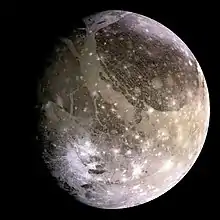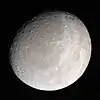ဂျန်နမိတ် (ဂြိုဟ်ရံလ)
ဂျန်နမိတ် /ˈɡænɪmiːd/[11] (Jupiter III) သည် နေအဖွဲ့အစည်းရှိ ဂျူပီတာဂြိုဟ်၏ အကြီးမားဆုံး ဂြိုဟ်ရံလများထဲမှ တစ်စင်းဖြစ်သည်။ အချင်း ၅၂၆၈ ကီလိုမီတာရှိပြီး မာကျူရီဂြိုဟ်ထက် ၈ ရာခိုင်နှုန်း ပိုကြီးသည်။[12] ယင်းသည် မိမိတို့သိရသည့် တစ်စင်းတည်းသော သံလိုက်စက်ကွင်း တည်ရှိသည့် ဂြိုဟ်ရံလစ်စင်းလည်းဖြစ်သည်။[13] ဂျန်နမိတ်သည် ဂျူပီတာဂြိုဟ်အား တစ်ပတ်လှည့်ပတ်မိရန် ၇ ရက်ခန့်ကြာသည်။ ဆီလီကာကျောက်နှင့် ရေခဲ အချိုးတူဖြင့် ဖွဲ့စည်းထားပြီး[14] အတွင်းပိုင်း သမုဒ္ဒရာ တည်ရှိကာ ကမ္ဘာပေါ်ရှိ ရှိသမျှရေထက် ဂျန်နမိတ်တွင်ရှိသော ရေသည် ပိုမိုများပြားနိုင်သည်။[15][16][17][18][19] ဂြိုဟ်ရံလ၌ ပါးလွှာသော အောက်ဆီဂျင် တည်ရှိသည်။[4] ဂျန်နမိတ်အား ဂယ်လယ်လီယိုက ၁၆၁၀ ခုနှစ်တွင် ရှာဖွေတွေ့ရှိခဲ့သည်။
 Image of Ganymede's anti-Jovian hemisphere taken by the Galileo orbiter (contrast is enhanced). Lighter surfaces, such as in recent impacts, grooved terrain and the whitish north polar cap at upper right, are enriched in water ice. | |||||||||
| ရှာဖွေတွေ့ရှိခြင်း | |||||||||
|---|---|---|---|---|---|---|---|---|---|
| ရှာဖွေတွေ့ရှိခဲ့သူ | ဂယ်လီလီယို | ||||||||
| ရှာဖွေတွေ့ရှိသည့် ရက်စွဲ | January 7, 1610[1][2] | ||||||||
အခြားအမည်များ | Jupiter III | ||||||||
| ပါဝင်အရာဝတ္ထုများ | Ganymedian, Ganymedean | ||||||||
| ပတ်လမ်း ဂုဏ်အင်များ | |||||||||
| Periapsis | 1069200 km[lower-alpha 1] | ||||||||
| Apoapsis | 1071600 km[lower-alpha 2] | ||||||||
ဆီမီး မေဂျာ ဝင်ရိုး | 1070400 km[3] | ||||||||
| ပတ်လမ်း ဗဟိုကျမှု | 0.0013[3] | ||||||||
ပတ်လမ်း ကာလ | 7.15455296 d[3] | ||||||||
ပျမ်းမျှ ပတ်နှုန်း | 10.880 km/s | ||||||||
| ပတ်လမ်း တိမ်းစောင်းမှု | 2.214° (to the ecliptic) 0.20° (to Jupiter's equator)[3] | ||||||||
| ဂြိုဟ်ရံလများ | ဂျူပီတာဂြိုဟ် | ||||||||
| ရုပ်ပိုင်းဆိုင်ရာ ဂုဏ်အင်များ | |||||||||
ပျမ်းမျှ အချင်းဝက် | 2634.1±0.3 km (0.413 Earths)[4] | ||||||||
မျက်နှာပြင် ဧရိယာ | 8.72×107 km2 (0.171 Earths)[lower-alpha 3] | ||||||||
| ထုထည် | 7.6×1010 km3 (0.0704 Earths)[lower-alpha 4] | ||||||||
| အရွယ်အစား | 1.4819×1023 kg (0.025 Earths)[4] | ||||||||
ပျမ်းမျှ သိပ်သည်းဆ | 1.936 g/cm3[4] | ||||||||
မျက်နှာပြင် ဒြပ်ဆွဲအား | 1.428 m/s2 (0.146 g)[lower-alpha 5] | ||||||||
အင်နားရှားကိန်း | 0.3105±0.0028[4] (estimate) | ||||||||
လွတ်မြောက်အလျင် | 2.741 km/s[lower-alpha 6] | ||||||||
လှည့်ပတ်ကာလ | synchronous | ||||||||
ဝင်ရိုးတိမ်းစောင်းမှု | 0–0.33°[5] | ||||||||
| Albedo | 0.43±0.02[6] | ||||||||
| |||||||||
မြင်သာသော အရွယ်အစား | 4.61 (opposition)[6] 4.38 (in 1951)[9] | ||||||||
| လေထု | |||||||||
မျက်နှာပြင် လေထုဖိအား | Trace | ||||||||
| လေထု၌ ဓာတုပါဝင်နှုန်း | အောက်ဆီဂျင်[10] | ||||||||
မှတ်စု
- Periapsis is derived from the semimajor axis (a) and eccentricity (e): .
- Apoapsis is derived from the semimajor axis (a) and eccentricity (e): .
- Surface area derived from the radius (r): .
- Volume derived from the radius (r): .
- Surface gravity derived from the mass (m), the gravitational constant (G) and the radius (r): .
- Escape velocity derived from the mass (m), the gravitational constant (G) and the radius (r): .
ကိုးကား
- Galilei၊ Galileo (March 1610)။ Sidereus Nuncius (PDF)။ University of Oklahoma History of Science။ 2005-12-20 တွင် မူရင်းအား မော်ကွန်းတင်ပြီး။ 2010-01-13 တွင် ပြန်စစ်ပြီး။
- NASA: Ganymede။ Solarsystem.nasa.gov (2009-09-29)။ 2010-03-08 တွင် ပြန်စစ်ပြီး။
- Planetary Satellite Mean Orbital Parameters။ Jet Propulsion Laboratory, California Institute of Technology။
- Showman, Adam P. (1999-10-01). "The Galilean Satellites" (PDF). Science 286 (5437): 77–84. doi:. PMID 10506564.
- Bills, Bruce G. (2005). "Free and forced obliquities of the Galilean satellites of Jupiter". Icarus 175 (1): 233–247. doi:. Bibcode: 2005Icar..175..233B.
- Yeomans၊ Donald K. (2006-07-13)။ Planetary Satellite Physical Parameters။ JPL Solar System Dynamics။ 2007-11-05 တွင် ပြန်စစ်ပြီး။
- Delitsky, Mona L. (1998). "Ice chemistry of Galilean satellites" (PDF). J. Geophys. Res. 103 (E13): 31,391–31,403. doi:. Bibcode: 1998JGR...10331391D.
- Orton, G.S. (1996). "Galileo Photopolarimeter-radiometer observations of Jupiter and the Galilean Satellites". Science 274 (5286): 389–391. doi:. Bibcode: 1996Sci...274..389O.
- Yeomans။ Horizon Online Ephemeris System for Ganymede (Major Body 503)။ California Institute of Technology, Jet Propulsion Laboratory။ 2010-04-14 တွင် ပြန်စစ်ပြီး။ (4.38 on 1951-Oct-03)
- Hall, D.T. (1998). "The Far-Ultraviolet Oxygen Airglow of Europa and Ganymede". The Astrophysical Journal 499 (1): 475–481. doi:. Bibcode: 1998ApJ...499..475H.
- GAN-i-meed, or as ဂရိ: Γανυμήδης
- Ganymede Fact Sheet။ www2.jpl.nasa.gov။ 2010-01-14 တွင် ပြန်စစ်ပြီး။
- Jupiter's Moons။ The Planetary Society။ 2007-12-31 တွင် မူရင်းအား မော်ကွန်းတင်ပြီး။
- Chang၊ Kenneth။ "Suddenly, It Seems, Water Is Everywhere in Solar System"၊ New York Times၊ March 12, 2015။ March 12, 2015 တွင် ပြန်စစ်ပြီး။
- Staff။ "NASA’s Hubble Observations Suggest Underground Ocean on Jupiter's Largest Moon"၊ NASA News၊ March 12, 2015။ 2015-03-15 တွင် ပြန်စစ်ပြီး။
- "Jupiter moon Ganymede could have ocean with more water than Earth – NASA"၊ Russia Today (RT)၊ 13 March 2015။ 2015-03-13 တွင် ပြန်စစ်ပြီး။
- Clavin၊ Whitney။ "Ganymede May Harbor 'Club Sandwich' of Oceans and Ice"၊ NASA၊ Jet Propulsion Laboratory၊ 1 May 2014။ 2014-05-01 တွင် ပြန်စစ်ပြီး။
- Vance, Steve (12 April 2014). "Ganymede's internal structure including thermodynamics of magnesium sulfate oceans in contact with ice". Planetary and Space Science 96: 62–70. doi:. Bibcode: 2014P&SS...96...62V. Retrieved on 2014-05-02.
- Staff (1 May 2014)။ Video (00:51) - Jupiter's 'Club Sandwich' Moon။ NASA။ 2014-05-02 တွင် ပြန်စစ်ပြီး။
This article is issued from Wikipedia. The text is licensed under Creative Commons - Attribution - Sharealike. Additional terms may apply for the media files.
